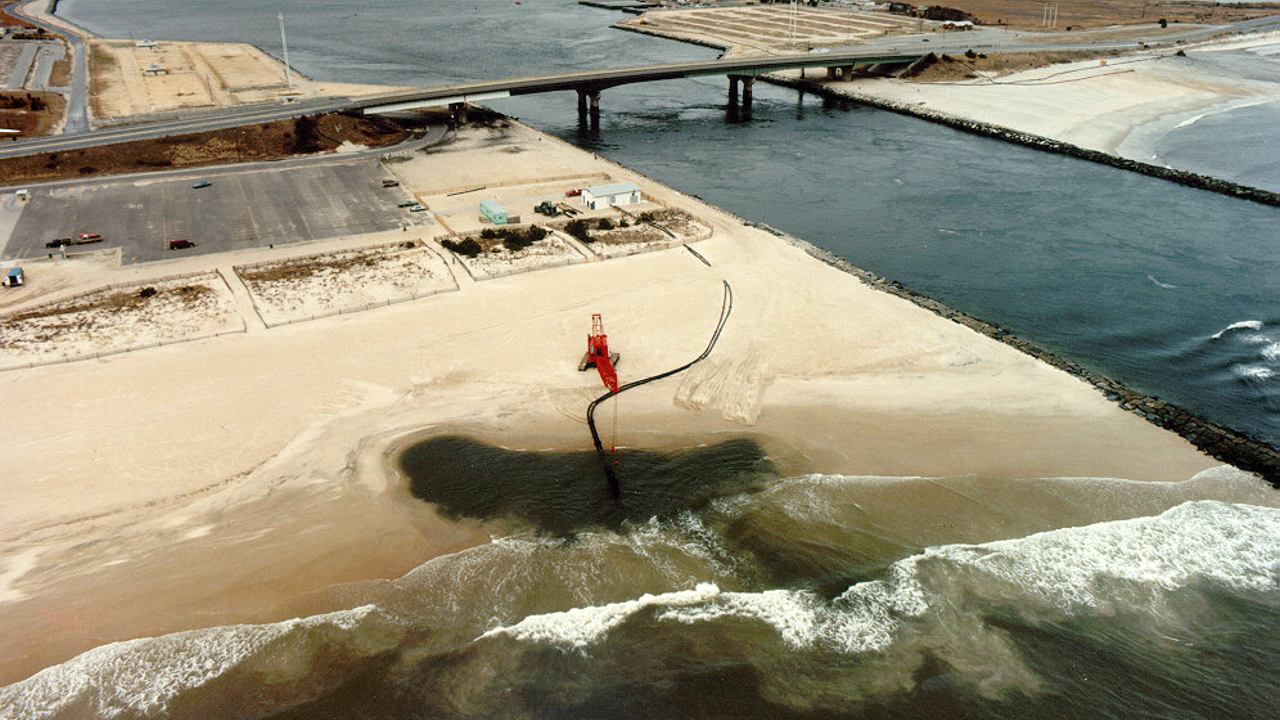DNREC to Begin Sand Bypass Testing July 14

This aerial photograph from the 1990s demonstrates how the sand bypass system sucks up water and sand, creating unstable conditions that can include dangerous rip currents. (U.S. Army Corps of Engineers)
Public Must Avoid Active Work Zones for Safety
Beach visitors at Delaware Seashore State Park must stay clear of designated areas around the Indian River Inlet starting Monday, July 14, as testing of the sand bypass system begins. Entering these active work zones during pumping operations is dangerous and strictly prohibited.
The bypass system will operate according to the following test schedule:
- July 14–17
- July 21–24
- July 28–31
- Aug. 4–6
Each Monday through Thursday, the system will run daily from 7 a.m. to 2 p.m.
Most of Delaware Seashore State Park and its beaches will remain open. However, temporary closed areas remain off-limits even when testing is not actively taking place.
During bypass system testing, the Delaware Department of Natural Resources and Environmental Control (DNREC) will be moving large volumes of sand through high-pressure pipes from the south side of the inlet to the north side. This process creates unstable conditions both in the water and on the beach within the restricted areas. Pumped sand becomes saturated and poses a serious risk of entrapment. Additionally, water conditions near the pumping zone may include dangerous rip currents.
Barriers and signage clearly mark restricted areas at the Indian River Inlet. DNREC staff will be present at the park’s public access points on both sides of the inlet to guide visitors and help enforce safety measures. White buoys with orange horizontal bands will mark the hazardous areas in the water.
Violations of park regulations can result in fines ranging from $50 to $250 for a first offense.
The bypass system is a mechanical operation that mimics the natural movement of sand along the Atlantic Coast, pumping sand from the inlet’s south side — where it accumulates — to the north side, where erosion is a persistent issue. Operating the bypass system helps maintain beach width, protect nearby infrastructure and improve coastal resilience. The system was offline for several years and has recently been upgraded with new pumps and a new electric motor. This summer’s testing ensures the upgraded system is fully operational before it can be placed into regular service.
For regular updates, follow DNREC and the Delaware Seashore State Park on social media.
Encuentre la versión en español
About DNREC
The Delaware Department of Natural Resources and Environmental Control protects and manages the state’s natural resources, protects public health, provides outdoor recreational opportunities and educates Delawareans about the environment. The DNREC Division of Watershed Stewardship develops and implements innovative watershed assessment, monitoring and implementation activities. The DNREC Division of Parks and Recreation oversees more than 26,000 acres in 17 state parks and the Brandywine Zoo.For more information, visit the website and connect with @DelawareDNREC on YouTube, Facebook, Instagram, X (formerly known as Twitter) or LinkedIn.
Media contact: Nikki Lavoie, nikki.lavoie@delaware.gov; Michael Globetti, michael.globetti@delaware.gov
###
Legal Disclaimer:
EIN Presswire provides this news content "as is" without warranty of any kind. We do not accept any responsibility or liability for the accuracy, content, images, videos, licenses, completeness, legality, or reliability of the information contained in this article. If you have any complaints or copyright issues related to this article, kindly contact the author above.
